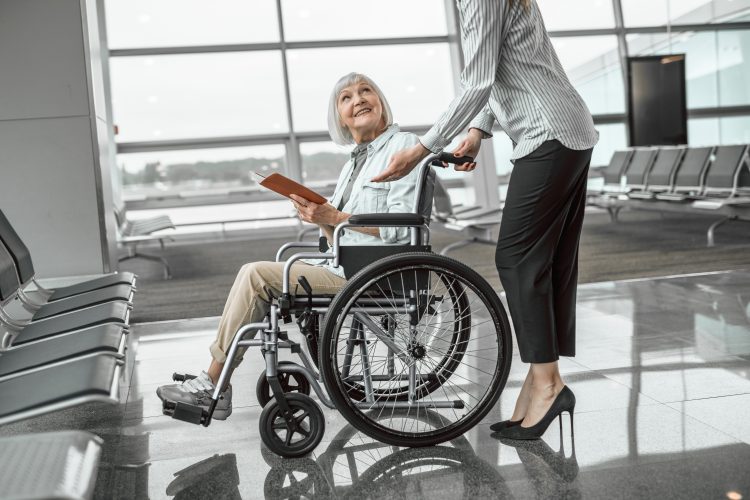Inclusive airports: Promoting awareness and positive disability perceptions
Posted: 1 October 2024 | Chris Jay | No comments yet
Following revelations about the treatment of air travellers with disabilities, Chris Jay, Managing Director and Founder of Bascule Disability Training, explores steps airports can take to foster a positive perception of disability.


If you watched Sophie Morgan’s recent UK documentary, Fight to Fly, you likely joined the nation in shock over the treatment of travellers with disabilities by certain airlines and airports. The Channel 4 programme (which aired in July 2024) exposed a level of mistreatment that was not only inhumane but also undignified and dangerous.
Morgan, a paraplegic TV Presenter and disability advocate, used the documentary to amplify her campaign for better conditions for travellers with disabilities, putting significant pressure on the airlines she exposed. The programme has since sparked a call for much-needed improvements in how these passengers are treated.
While the documentary primarily focused on airlines, it also cast a critical eye on airports, using undercover footage to highlight the troubling experiences of wheelchair users at some UK airports. Sadly, the staff featured in the programme failed to treat travellers with basic dignity or respect, demonstrating a glaring lack of disability awareness.
Join us live: Shaping the Next Generation of Hold Baggage and Air Cargo Screening
Join us live for an insightful webinar on 11th December at 14:00 GMT, in collaboration with Smiths Detection, as we explore the strategic balance of operational efficiency, regulatory compliance, and sustainability in high-volume security environments.
This session offers a focused look into future-proofing your security strategy.
Key learning points
- Cost Reduction: Strategies to minimize bag travel time while simultaneously reducing operational costs.
- Regulatory Roadmap: Insights into the next wave of regulatory changes and their impact on future investment decisions.
- Sustainable Systems: Practical approaches to building sustainability into security systems and lowering the total cost of ownership (TCO).
- Scalable Solutions: Real-world examples of scalable systems supporting current airport growth and preparing for tomorrow.
Register now for expert insights, case studies, and actionable strategies on operational efficiency!
This documentary has ignited a crucial conversation about how airports and airlines must work together to address these accessibility failures. The pressing question now is: Where do we start in making meaningful changes to ensure airports improve their treatment of travellers with disabilities?
Changing minds
As with all accessibility challenges, the first, and most crucial step, is fostering a more positive perception of disability among airport staff. At the end of Morgan’s documentary, she correctly states that change will only come with a shift in attitude. The most effective way to achieve this is by implementing comprehensive disability awareness training programmes across all teams.
If implemented correctly, awareness training should lead to a cultural shift that positively impacts how people are treated, fostering greater empathy, understanding, and support for individuals with disabilities. However, it is imperative that this training is not viewed as a simple tick-box exercise. Adequate facilitators, preferably those with disabilities themselves, should be sourced.
Providing fast, low-quality e-learning packages may seem like a quick fix, but for meaningful change, training must involve an in-depth exploration of what disability is. This should include modules on aspects such as etiquette, communication, language, non-visible disabilities, improving customer service, legislation, and developing accessible airport environments.
For true change, the education of all airport staff, including those at the top of the hierarchy, must be considered. Training decision-makers increases the chances of accessibility being considered in the airport’s broader decisions and strategic developments.
For customer-facing staff, awareness training is imperative if airports are to provide accessible and inclusive service. Whether it’s passenger assistance staff, security, customs and immigration officers, or information desk agents, these employees must have a high level of disability awareness. This also includes workers who may not interact face-to-face with the public, such as those in call centres or responding to external emails. It’s also worth assessing and monitoring the training of any third parties or contractors, as they too reflect the airport’s service.
This will prepare anyone interacting with the public, equipping them with the knowledge and understanding required to recognise and appropriately respond to the needs of customers with disabilities. When things go wrong, the current ‘blame game’ between airlines and airports helps no one, especially passengers with disabilities.
Understanding the importance of mobility aids
Damage to mobility aids in airports is, sadly, a common occurrence with serious implications. Morgan’s documentary revealed that one in four people with disabilities who use a wheelchair or other mobility aid reported it had been lost or damaged while flying, and one in five of those were not properly compensated.
While handling this equipment largely falls on the responsibility of the airline, third-party luggage handlers often muddy the issue. Furthermore, there are times when special assistance airport staff handle, move, and transport these items. Any staff with such responsibilities should be acutely aware of the importance, value, and significance these items hold in people’s lives. Even the slightest damage through inconsiderate handling can create an enormous impact on the lives of air travellers. Damaging, losing, or compromising these aids is equivalent to taking an able-bodied person’s legs away.
Etiquette and communication
In another segment of Morgan’s documentary, a member of the airport staff moves a person’s wheelchair without their consent and speaks to them like a child, claiming they were going “on and on” when they complained.
Moving a person’s wheelchair without their consent is inappropriate, demeaning, and disrespectful. However, in most cases, the person is completely unaware of how rude this is. With the right awareness training, it would have been clear that this and similar behaviours are unacceptable. With an improved understanding of disability and training in the correct etiquette, it’s unlikely a staff member would make such obvious mistakes.
Changing how we perceive disability and developing a more in-depth understanding of etiquette will mean that staff will approach passenger support in an entirely different way, perceiving the passenger empathetically, as a human being, rather than simply seeing them as their disability or an added challenge.
Another area of the documentary revealed that a passenger with a disability was labelled and openly referred to as a “special” by a member of the airport staff. Again, developing awareness and an improved attitude towards disability will encourage empathetic communication and appropriate language, ensuring staff approach each interaction with respect.
Awkward interactions
It may sound outdated, but a lack of experience interacting with people with disabilities can impact how people behave when they do encounter them. This means staff members can easily make mistakes or act inappropriately when they feel awkward or uncomfortable around people with disabilities. While this may sound uncommon, Scope revealed that 67% of the British public feel awkward around people with disabilities. That’s over two-thirds of people who, without any experience and knowledge of disability, struggle to interact with 24% of the population. This is further compounded by the fact that English may not be someone’s first language.
A well-designed awareness training programme will help staff gain a comprehensive understanding of the challenges faced by people with various disabilities. This knowledge fosters greater patience and empathy, crucial for improving accessibility and delivering excellent customer service. In addition to enhancing empathy and patience, this focus will provide staff with essential communication techniques, appropriate language use, and general etiquette to ensure respectful and effective interactions.
The disabilities you can’t see
When we think about disability, most of us think of visible aids like wheelchairs, walking aids, white sticks, or service dogs. However, only a small percentage of disabilities are visible—in fact, 80% are non-visible or “hidden.” Unfortunately, if airport staff are unaware that a customer has a disability, they may unintentionally provide a poor customer experience due to misunderstandings or unwarranted negative perceptions of the customer’s behaviour. By implementing a few straightforward adjustments, you can better accommodate the needs of individuals with hidden disabilities.
What is a non-visible disability?
Simply put, non-visible or hidden disabilities cannot be seen and are not immediately apparent. These encompass a range of physical, sensory, neurological, or mental conditions. Examples include mental health issues, personality differences, the autism spectrum, dementia, learning disabilities, chronic pain, respiratory conditions, MS, diabetes, as well as visual and hearing impairments, among others.
Although addressing the diverse needs of individuals with non-visible disabilities might seem challenging, implementing a few small adjustments can significantly enhance customer experience and ensure it is inclusive for everyone.
One of the most important things to remember is that staff should avoid making assumptions or jumping to conclusions regarding whether someone has a disability. A good example would be confusing a person’s learning disability with certain behaviours.
I once witnessed a young man in an airport, who appeared to be neurodiverse, walk away from his family and past operators at a gate where staff were examining tickets. They were immediately alarmed and asked him many questions. The young man used sensitive and inappropriate words that would have ordinarily triggered airport security to intervene. Luckily, the nearby manager had some experience and knowledge of disability, recognised the situation, and resolved it accordingly by locating the young man’s parents without unnecessary issues. That scenario could have been much worse if staff had no experience, training, or knowledge of hidden disabilities.
If passenger-facing staff have a strong understanding of what a hidden disability is, they will be more skilled, empathetic, and knowledgeable, which contributes to the airport providing an inclusive service.
Offering help
One should never make bold assumptions about what assistance a customer does and doesn’t need, and tread carefully when asking about requirements. Hidden disability sunflower lanyards are great for signalling that some customers may have additional needs, but not everyone may wish to disclose their disability, something people working with the public should be aware of. Preparing staff to always consider disability and discreetly offer support will only enhance the service they already provide.


Bascule
If staff are trained to follow social cues, communicate clearly, discreetly recognise, and address forms of discomfort, these qualities will enhance the service all travellers receive.
Getting it right: Changi Airport
An excellent example of inclusive practice and pre-planned passenger assistance can be found at Changi Airport in Singapore. Besides making many physical changes to the airport, Changi has taken specific measures to address disability, particularly the unique challenges faced by individuals with non-visible disabilities. The airport fosters an inclusive, stress-free travel experience by providing a customisable digital guide before a visit, detailing the journey from check-in to boarding.
Passengers with non-visible disabilities can access bespoke lanyards to indicate they require additional assistance and use various supportive tools. Changi Airport has also trained 300 frontline staff to recognise signs of invisible disabilities and assist these passengers using the ‘Observe, Wait, and Listen’ (OWL) approach.
Final thoughts
In summary, an airport’s goal must be to ensure that every passenger, regardless of their abilities, can navigate their journey with confidence and ease, knowing that their needs are understood and respected. Supporting passengers with disabilities requires understanding, knowledge, experience, and above all, empathy, to ensure they are treated with dignity and respect.
All of this begins with a shift in mindset and the development of an inclusive organisational culture that values disability awareness at every level of operation. Equipping staff with the skills they need will pave the way for an improved perception of disability and a more inclusive airport experience.
About the author


C: Bascule
Chris Jay is the Founder and Managing Director and a training facilitator of the disability awareness training provider, Bascule Disability Training. Born with cerebral palsy, Chris has been a wheelchair user for over 25 years and has used his life experience of disability to provide organisations with user-led, awareness training packages and consultation services. As a speaker, author and disability inclusion advocate, Chris’ career has been built around his passion for developing accessibility and inclusivity for people with disabilities.
The International Airport Summit is open for registration!
Date: 19 – 20 November 2025
Location: JW Marriott Hotel Berlin
At our flagship event of the year, we will dive into the future of airport operations, with expert-led sessions on passenger experience, innovative smart technologies, baggage handling, airside operations, data, security, and sustainability.
This is where global airport leaders come together to share insights, challenges, and real-world solutions.
Limited complimentary passes are available for eligible professionals – first come, first served!
Related topics
Accessibility, Airport construction and design, Passenger experience and seamless travel, Passengers with reduced mobility (PRMs), Recruitment and training, Safety, Workforce

















